We live in a time where handgun red dots sights are extremely prevalent. We have red dot sights in all sizes, shapes, and designs, but until now, we only had one designed to utilize an enclosed emitter.
The Aimpoint Acro introduced us to the idea of a tiny red dot with an enclosed emitter, and that idea has grown legs. Holosun has since released the HS509T, and SIG’s new Romeo2 is a quasi-enclosed emitter design. Today we are looking at the HS509T from Holosun.
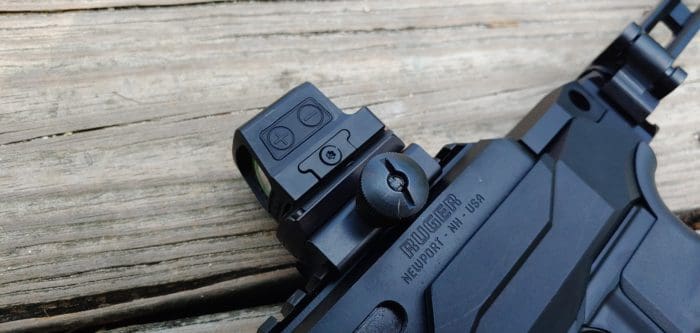
Holosun’s big claim to fame is its ability to produce high-quality optics at a great price point. The enclosed unit HS509T tips the scales a bit more price-wise. While it’s less expensive than the Acro (by about $175 retail) and even the RMR, the HS509T still costs over $400. While it might be the least expensive enclosed emitter red dot, it’s far from being inexpensive. Is the juice worth the squeeze?
What’s the Deal With an Enclosed Emitter?
Open emitter red dots rule the market when it comes to the realm of pistol optics. Trijicon,, Leupold, SIG, Burris, Docter, Meopta, and more make these single-lens optics for handguns.
While I’ve never heard of it actually happening with an open emitter, stuff can get between the window and the emitter. When that happens, you can lose your red dot or have a distorted dot image when you draw and aim.
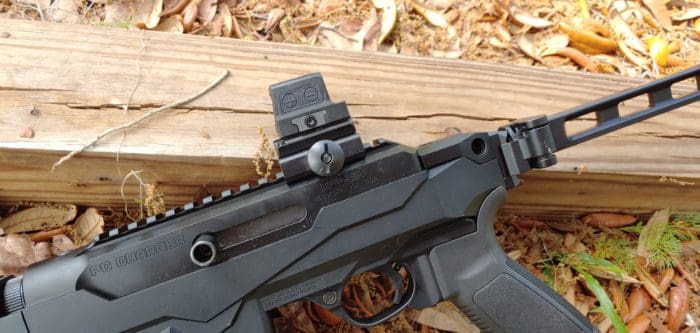
Rain and water, in particular, can set on the emitter and cause distortion of the red dot. Also, anything that finds its way between the emitter and the lens can disable the dot, be it mud and dirt, snow, or whatever else can fit in there.
An enclosed emitter optic like the Holosun HS509T provides protection to the emitter and ensures nothing gets between the lens and the emitter. If reliability is your biggest concern, then an enclosed emitter is the way to go. Nothing can get between the emitter and the window, and your chances of failure decrease a little bit.
Breaking Down the HS509T
Like the Acro, the HS509T mounts to a plate, and the plate mounts to your pistol slide, or in my case, to my optics mount. Where Holosun differentiated was making their plate RMR-compatible. The Trijicon RMR is the closest thing we have so far to an industry standard footprint.

That was a wise move on Holosun’s part because to hell with trying to find new mounts and slide footprints. You can have a slide cut to drop the plate and mount the HS509T directly to your slide, but who wants to do that? The plate that comes with the HS509T is made from steel and quite tough.
Since it’s a Trijicon footprint, I could easily find a Trijicon mount to make it easy to mount the HS509T onto my Ruger PC Charger pistol.

The Holosun HS509T has the multi-reticle system Holosun has become known for, and this specific model features two reticles. We get either a simple 2 MOA dot and a 32 MOA circle with a 2 MOA dot in the center. The circle and 2 MOA dot give shooters with astigmatism a better option than a red dot alone. Also, bigger can be better for speed shooting.

The sight has ten daylight level brightness settings and two-night vision settings. We get 50K hours from the side-loaded 1632 battery. Backing that battery up is the Holosun solar panel that provides backup power for the battery.
The optic weighs 1.72 ounces, 1.21 inches wide, 1.61 inches long, and 1.35 inches tall. It’s smaller than the Acro and has a wider rather than taller window. The T in HS509T stands for titanium, which is used for the housing of the HS509T.
Putting The HS509T Into Action
Off the bat, I love the ergonomics. I hate single control red dots, and the HS509T gives me two easy-to-access buttons. They’re rubberized and very easy to use. Making adjustments, swapping reticles, and turning the optic on and off takes zero effort.
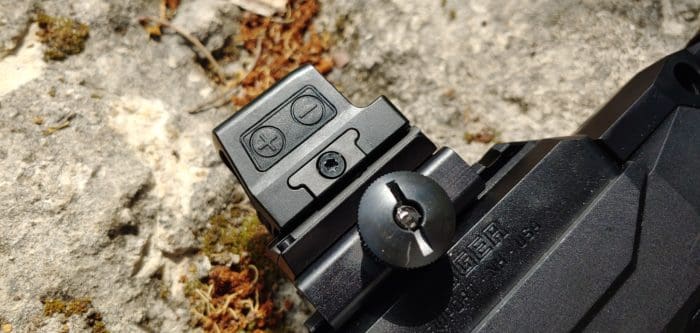
Swinging it rapidly from target to target reveals zero distortion. I didn’t find any lag with the red dot or stuttering as I swung the gun rapidly. I also wanted to see if the optic would cause some ‘halo’ effect depending on varying light conditions. I tried with the sun to my back and to my front and saw no noticeable halo effect in the optic.
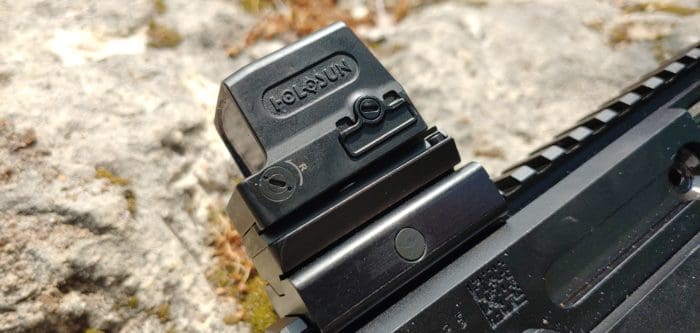
Zeroing requires a small flat-headed tool. The turrets won’t work with brass or coins. You need a dedicated flat head tool. I did a quick 25-yard supported zero and didn’t have any noticeable issues. From testing a lot of other optics, I’ve learned that turrets can be a real weak point.
With this in mind, I moved the optic and mount to several different guns and zeroed them one after the other. I zeroed the HS509T on a AR-10, a CZ Scorpion, a Mossberg 930 SPX, a CMMG Banshee, and finally, the Ruger PC Charger. The 1 MOA adjustments stayed consistent between each gun.
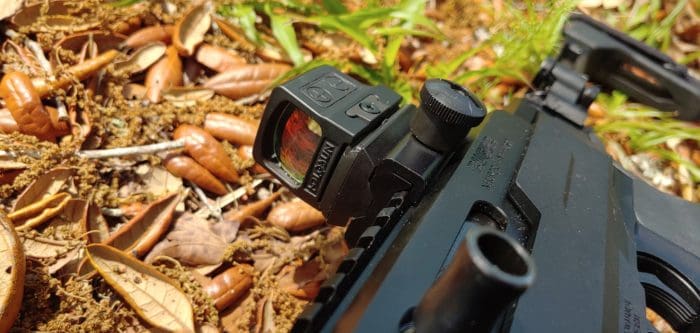
The HS509T also held zero between the multitude of different weapons it was mounted to. Even the ol’ semi-auto 12-gauge couldn’t make it tap out. I used the AR-10 and shotgun to see if I could get the optic to stutter or blink between shots. Sometimes rough recoil reveals poor battery connections and makes the optic shut off between shots. No such issues arose with the Holosun HS509T.
Doing Some Real Shooting
Once I dialed into my final platform, I went forward with some more longevity-based testing. I started at 25 yards and moved back to the 50, 75, and 100-yard lines. At 25 to 50 yards hitting targets both large and small was plenty easy. Back off to 75 and 100 yards, I had to start estimating for drop. At these distances, the smaller 2 MOA reticle made a lot of sense when shooting at small targets.
On big man-sized targets, I could use the 32 MOA and 2 MOA reticle and use it to estimate for drop. At 100 yards, I aimed the dot at the head and then used the top of the bottom stadia to drop shots into the chest of a man-sized IPSC target with relative ease.

At 25 yards, the big 32 MOA circle and dot worked perfectly, especially when speed was needed. Snapshots, transitions, and the like were quite easy with this massive reticle and the HS509T. I snapped through a series of four steel gongs ranging from four to ten inches, one after the other in less than four seconds.
I ran a few failure-to-stop drills with the HS509T, and the big reticle made it quite quick to get the shots on the chest and still easy to place well-aimed shots onto a target’s T-zone.
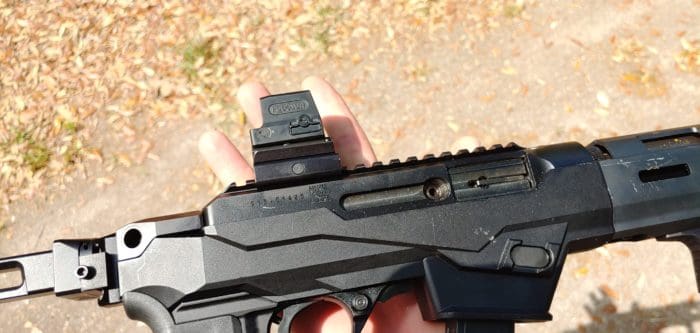
At 50 yards and beyond, that big reticle obstructed the smaller gongs a bit too much to be very useful. Bigger targets weren’t an issue, but small targets were too tough to see for it to be useful. Swapping reticles just requires the use of the (-) button, so it’s quick and easy to change.
HS509T Clarity and Coolness
One of the downsides of an enclosed emitter optic is that two lenses create more distortion than one lens. The image isn’t badly distorted, but you notice a slight difference between two lenses and a single lens. A lenses produce a heavy blue tint, but that serves a purpose. It makes the dot appear brighter, allowing you to use a lower setting and keep the batteries lasting longer.
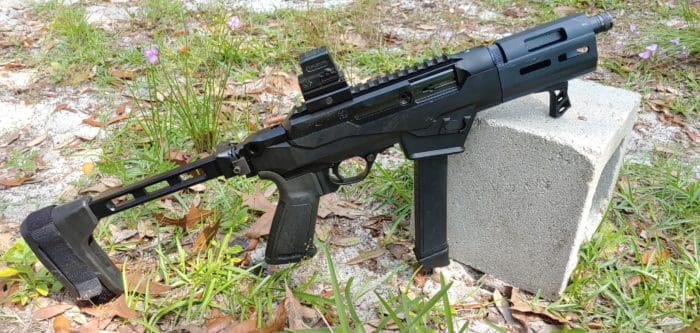
As a red dot, especially a red dot this small, clarity isn’t a make-or-break factor, and it’s plenty clear to be used within 100 yards. When used in low light, it provides a bright, clear picture and provides no issues regardless of external light conditions.
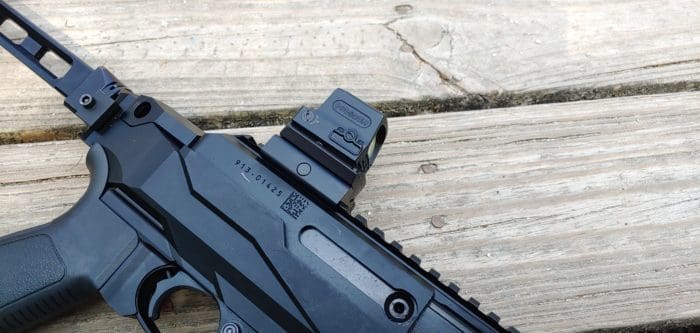
Overall, the Holosun HS509T is a solid little optic that provides a compact, reliable aiming solution for handguns, rifles, and braced pistols. It’s an interesting design that departs from most pistol-sized red dots. It’s not the cheapest option, but it’s worth the money.
Specifications: Holosun HS509T Red Dot Sight
Power Source – Solar & Battery
Battery Type – CR1632
Battery Life – 50000 hours
Brightness Setting – 10 DL&2 NV
Window Size – 0.66×0.9
Length – 1.61 inches
Height – 1.35 inches
Width – 1.21 inches
Weight – 1.72 ounces
Price: $429 retail
Ratings (out of five stars):
Clarity * * * *
The HS509T might have two lenses and a blue tint, but it’s still quite clear. It makes it easy to see and engage with targets out to 100 yards. That tint provides a useful function, but it’s still work noting.
Ergonomics * * * *
You have two easy-to-access buttons and a side-mounted battery…that gives it high marks. It’s boxier and a bit heavier than most pistol-sized red dots, and the use of a plate makes it sit a bit higher unless you get a slide cut specifically for the HS509T.
Ease Of Use * * * *
Getting the HS509T into action doesn’t take much effort. Swapping reticles, changing brightness levels, swapping batteries, and using the optic at various ranges are all easy and simple to do. I knocked one point off for the need for a dedicated tool to make adjustments.
Overall * * * *
The HS509T offers a lot of optic. The enclosed emitter optic means top-of-the-line reliability and unbeatable durability. Add in the titanium construction, a solar panel, and multiple reticles, and you have a rock-solid optic.

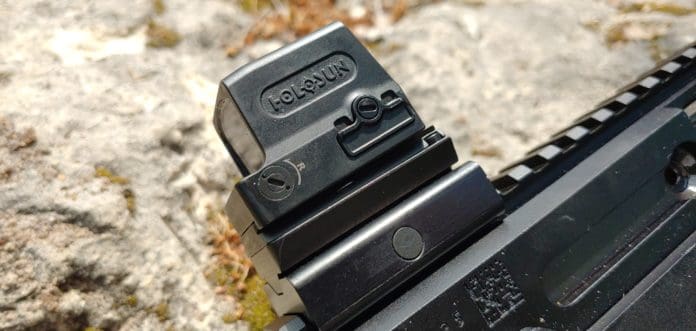



Not testing it on a pistol when that’s the entire claim to fame is kinda pointless…
Question: can i disable remote kill switch controlled by PLA?
Come on man its not like its a baofeng
“… its not like its a baofeng”
*Burn*….
*Snicker* 😉
Full disclosure I do use baofeng as it is a cheap and relatively effective option for fun. For anything serious I would look elsewhere but in a pinch it functions unless the kill switch is a thing.
I owned one of these new HS509-T sights, briefly, but got rid of it because Holosun lied about the specs, like they usually do. That is false advertising, and you should deduct at least one point from reviews of products when the manufacturer lies so tremendously about the weight.
When reviewing Holosun’s sights, you need to realize that Holosun always lies about the weight of their sights (sometimes they also lie about the dimensions of their sights). You made the same mistake in your April 14th review of the Holosun HS510C, another red dot sight for which Holosun lies about the weight, but Holosun also lies about the size of the HS510C, so in that review, you got both the size and the weight wrong by using Holosun’s advertised specs, which are very dishonest, false advertising by that company. You should deduct two points from your April 14th review of the HS510C for the manufacturer lying about both the size and the weight of that optic.
In both reviews, you simply took Holosun’s word for it about the weight, instead of weighing the optics yourself. If you’d weighed the HS509T, you would have found out it weighs 3.4 oz, exactly TWICE as much as Holosun’s advertised weight of 1.72 oz. In your April review of the Holosun HS510C, if you’d weighed it, you would have found out that it actually weighs 7.6 oz, which is 2.64 oz more than its advertised weight of 4.94 oz. Please don’t trust Holosun about the size and weight of their products, because they don’t tell the truth in their specifications. A good reviewer always measures and weighs themselves, rather than taking the manufacturer’s word for it, especially when dealing with Chinese manufacturers.
For this HS509T sight, Holosun claims it weighs 1.72 ounces, and you simply took their word for it. The actual weight of the HS509T is TWICE the specified weight: 3.4 ounces (including the steel mounting plate because that’s required). This is TWICE the advertised weight, and THREE TIMES the weight of my RMR. If you include the Picatinny mount (which attaches the Holosun HS509T and its plate to the rail), then the HS509T weighs about 6 ounces, still 2.2 ounces more than an RMR with the same mount.
Even if you exclude the steel mounting plate, the HS509T still weighs 2.2 ounces, but since the steel mounting plate is REQUIRED (in addition to the RMR mount), it must be included in the weight, so the HS509T weighs 3.4 ounces, twice the advertised weight, and again, THREE TIMES the weight of my Trijicon RMR.
The American-made Trijicon RMR dual-illuminated (solar/tritium) model retails for the same price as the Chinese-made HS509T, and they both have the same size window, but the Trijicon is half the weight, smaller, and much more durable, so why go with a Chinese-made Holosun that weighs twice as much, requires batteries, and requires a special tool to adjust? That’s why I quickly got rid of the Holosun HS509T and replaced it with another Trijicon RMR.
You should deduct at least one point from the Holosun’s products when they lie so tremendously about the weight of their optics (and they sometimes lie about the size, too. With the HS510C, they lie tremendously about its height and width, as well as about its weight). Because Holosun lied about the size and weight of the HS510C as well as the HS509T, I sold both of my HS510C sights as well as my HS509T sight.
Correcting my own comment above (this part should have said the HS509T is THREE times the weight of the RMR).
The American-made Trijicon RMR dual-illuminated (solar/tritium) model retails for the same price as the Chinese-made HS509T, and they both have the same size window, but the Trijicon is ONE-THIRD the weight, smaller, and much more durable, so why go with a Chinese-made Holosun that weighs THREE times as much, requires batteries, and requires a special tool to adjust?
Noted for future optics shopping/comparisons. Haven’t looked into buying optics in a long while but good knowing a second verification is needed for the chinese options re specs.
Trying to sharp shoot the author but then you lie about the Trijicon RMR dual illuminated. The dual illuminated uses fiber optics and tritium not solar and tritium. If you’re going to go that deep in the weeds make sure you don’t screw up simple details like that.
If you’re going to be as inconsiderate and nitpitcky to try and “disprove” a good analysis by pointing out a single perceived flaw, I’ll return the favor.
Technically, he is correct. The light that is used to illuminate the sight is generated either by the Sun (solar) or radioactive isotope decay (tritium).
The fiber optics merely channel the light. Unless, of course, you know some way to make glass generate photons on its own. If you’re going to be a rude pedant, at least have the self-respect to not be wrong yourself.
If you’re going to try to prove me wrong at least use common words as they are generally understood by the vast majority of the public. Hardly anyone uses the word solar in reference to a fiber optic component. They often say sunlight as Trijicon does in their description of the sight they make, “The Dual-Illuminated RMR uses fiber optics and tritium to illuminate the reticle. Fiber optics collect ambient light, automatically adjusting the reticle brightness. In situations with no (or low) light, the tritium illuminates the reticle. This version is popular with shooters who prefer a battery-free solution. The RM04 family has an amber 7.0 MOA dot, which is simple to use and easy to find. The 7.0 MOA dot is popular for those wanting our smallest aiming point in our Dual-Illuminated models.” Notice that at no point do they use the word solar. Solar is most often used to refer to a solar panel not the illumination of a fiber optic. Nice try
The plate is not required. It was not required to mount on my pistol. So the weight is correct.
Without the Vulcan reticle? Pass…
The red dots cool but what if someone was peeking at you from behind that tree?
The housing covers them up.
You might not have lost your dot, but plenty of us competition shooters who use open emitters have lost the dot when rain gets in the emitter.
You neglected the Deltapoint Micro which is an enclosed tube.
There are so many Holosun haters…sorry guys they are affordable extremely well made items…Chinese, yes. Maybe some of the American optics manufacturers should become more competitive instead of whining about a Chines manufacturer…never though America was a country that whines about competition. I thought we were competitive doers instead of whiny poopy baby butts. Shame on America, complaining instead of being less gready and actually competing against a competitor.
one of the few to pass Sage Dynamic’s torture tests.
Exactly. This country has become a country of “Everyone gets a Trophy” mentality, instead of an “I win because I beat you fair and square” mentality. Sad, that corporate greed and that liberal mindset got us here.
GM is American, look at all the trash they manufactured over the last 50 years…I could say the same for the Democratic party.
In as much as I buy American when I can, if it serves me well, but not to the extent of cutting my nose off despite my face. After extensive research and evaluating my need, recognizing that I’m not trudging through a desert hunting Taliban, I purchased a Holosun HS507C X2. It had features I desired that other brands didn’t and it was priced right. This allowed me to take my Aimpoint T1 Micro (which I paid dearly for) off my AR and put it back on the AK and mount the 507 on my AR 300 blk pistol on top of an American Defense AD-RMR-CO STD. I REALLY like the set up and you know what, I don’t give a flying bat-sh– what anyone else thinks.
Chinese manufacture: Take a look at anything you buy. Especially small things. You are ALL buying Chinese stuff. I’ve read that over 70% of or drug components come from China and about 70% of the final product comes from India.
How did this happen? EVERYONE shops by price and quality, mostly price.
Our FEARLESS leaders are only catering to what we want. Most of our garlic comes from…….China.
They need us and we need them.
Enjoy your Iphone, it was made in China.
Can it be seen through NVG’s?
Comments are closed.